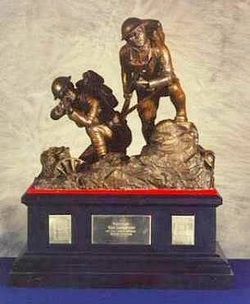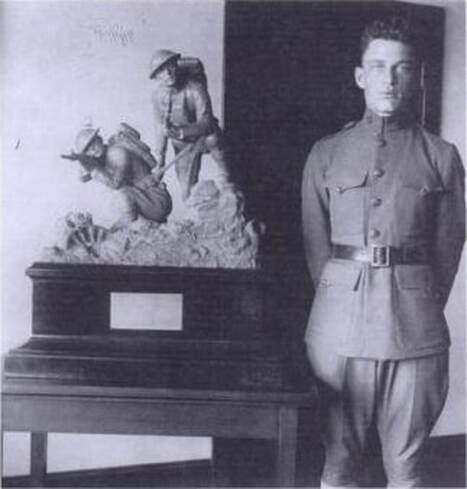1922 (Copyright 1923):
THE UNITED STATES INFANTRY ASSOCIATION TROPHY
(AKA THE INFANTRY MATCH TROPHY)

The trophy is a rare commissioned bronze.
According to a Viquesney brochure, Chief of Infantry of the U.S. Army, Major General Charles S. Farnsworth was so impressed with the miniature "Spirit of the American Doughboy" that he commissioned this piece for the U.S. Infantry Association (however, he didn't pay for it; see "The Real Story", below).
It is a one-of-a-kind cast bronze by Viquesney, and was originally on display inside the Infantry Building in Washington, D.C., but since 1936 has been in the custody of the National Board for the Promotion of Rifle Practice (NBPRP). A plaster version now resides in the Owen County Heritage and Culture Center in Spencer, Indiana. It was bought from a man who in turn bought it from the estate sale of someone named Hattie Hyden of Ellettsville, Indiana.
The figure on the right may have been the inspiration for both Viquesney's "Zero Hour" and his version of "Over the Top", except that here it's the proper left knee that's raised forward; on the other two sculptures it's the right knee that's raised.
It is a one-of-a-kind cast bronze by Viquesney, and was originally on display inside the Infantry Building in Washington, D.C., but since 1936 has been in the custody of the National Board for the Promotion of Rifle Practice (NBPRP). A plaster version now resides in the Owen County Heritage and Culture Center in Spencer, Indiana. It was bought from a man who in turn bought it from the estate sale of someone named Hattie Hyden of Ellettsville, Indiana.
The figure on the right may have been the inspiration for both Viquesney's "Zero Hour" and his version of "Over the Top", except that here it's the proper left knee that's raised forward; on the other two sculptures it's the right knee that's raised.
The Real Story
It was estimated that the cost of the trophy and associated medals over the first ten years would be approximately $1,500, and although General Farnsworth commissioned Viquesney to produce the piece, it was other officers and enlisted men who raised the money for it by private subscription (no more than $1 from officers; 10 or 15 cents from enlisted men). The trophy was completed and then presented to the National Rifle Association in 1922, in time for its 1923 competition. The trophy was initially awarded to the winning team competing as a combat squad. The piece was copyrighted on July 26, 1923.
After 1940, with the approach of another expected war, the trophy fell into disuse until 1955, when the Army Department revised the match in a different form.
After 1940, with the approach of another expected war, the trophy fell into disuse until 1955, when the Army Department revised the match in a different form.

